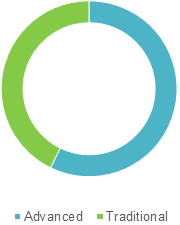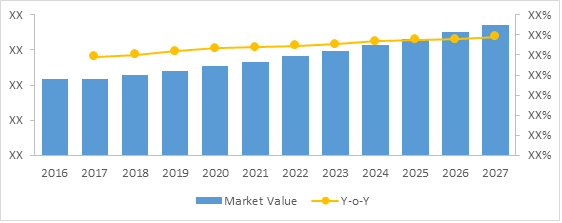Wound Dressing Market – Insights
Diabetes UK (operated by The British Diabetic Association) estimates that diabetic patients are at 30 times higher risk of having an amputation compared to general population. Due to such high probability, a large number of amputation surgeries are witnessed each year, subsequently requiring effective wound dressing to prevent post-surgery infections. Wound dressings are classified into three categories, namely active, passive, and interactive dressings. Passive wound dressing products have only protective function and active wound dressings promote healing by creating moist wound environment. Thus, demand for advanced wound dressings such as hydrogels and foams is expected to increase subsequently.
Interactive dressings create moist wound environment and also interact with wound bed components to enhance wound healing. Wound dressings such as hydrogels and alginates dressings require secondary dressing, as they are permeable and non-occlusive. Composites multi-layer dressings are relatively expensive and can be used in primary and secondary wound dressing. The global wound dressing market is expected to be driven by increasing demand for advanced wound dressings.
The global wound dressing market size was valued at US$ 6,956.4 million in 2018 and is expected to exhibit a CAGR of 6.2% over the forecast period (2019 – 2027).
Global Wound Dressing Market Share (%) Analysis, By Product Type, 2019

To learn more about this report, Download Free Sample
Source: Coherent Market Insights Analysis (2019)
Increasing patient pool is expected to drive growth of the global wound dressing market
According to the American Diabetes Association (ADA), around 1% to 4% of the diabetic population in the U.S. are estimated to be affected by diabetic foot ulcers annually. Moreover, according to Diabetes UK, prevalence of diabetic foot ulcers in diabetic patients was estimated to be 2.5%, which accounted for around 86,000 people in the U.K. in 2015. Moreover, according to the same source around 7,400 leg, foot or toe amputation procedures are conducted every year in England.
According to the World Health Organization (WHO) 2016, there are around 265,000 deaths globally every year due to burns. Moreover, as per the WHO, over 100,000 people in India suffer from burns every year, while burns are the second most common injury in Nepal accounting for 5% of disabilities. High prevalence and incidence rate of burns provide opportunities to market players to capitalize on different patient groups in the global wound dressing market.
Wound Dressing Market - Restraints
Challenges in the wound dressing market such as product recalls, availability of alternative products, and high cost of wound dressing products are expected to hamper the global wound dressing market growth over the forecast period. Increasing number of product recalls is due to product failure, component inconsistency, and packaging problems. For instance, in August 2018, the U.S. Food and Drug Administration (FDA) initiated product recall of Simpurity Hydrogel Absorbent Sheet wound dressing from Safe N Simple, LLC, as the sterilization process performed on the dressing equipment was not certified by the U.S. FDA. Over the long term, it is possible that product’s quality might get deteriorated. The product recall process is still under inspection.
Furthermore, according to 2015 report by the College of Pediatric Medicine, 9%-20% of patients in the U.S. with diabetic foot ulcers require hospitalization. The report also states that the cost of treatment with advanced wound dressings is sometimes double when compared to conventional wound dressings. Moreover, according to the WHO, burn injuries are more prevalent in low and middle income countries. Therefore, companies need to develop cost-effective products for the large patient population in low and middle income countries of Asia-Pacific, Africa, and Latin America. The availability of wide range of affordable products is expected to fuel growth of the wound dressing market in these regions over the forecast period.
Wound Dressing Market - Regional Insights
On the basis of region, the global wound dressing market is segmented into North America, Latin America, Europe, Asia Pacific, Middle East, and Africa. North America is expected to hold dominant position in the global wound dressing market over the forecast period, owing to increasing product launches of wound dressing equipment, rising prevalence of chronic wounds, and strategic partnership between key players. For instance, in April 2017, ConvaTec Group Plc. launched Foam Lite ConvaTec dressing in the U.S. for the treatment of acute and chronic wounds.
Furthermore, Europe market is expected to exhibit growth over the forecast period, owing to rising prevalence of burn cases in Europe. This will increase demand for its treatment in this region, which in turn is expected to drive growth of the market. For instance, according to the National Center for Biotechnology Information 2015 report, in Europe, 50% of the patients were hospitalized due to severe burns in 2015.
Global Wound Dressing Market Value (US$ Mn) & Y-o-Y Growth (%), 2017-2027

To learn more about this report, Download Free Sample
Source: Coherent Market Insights Analysis (2018)
Wound Dressing Market - Competitive Landscape
Key players operating in the global wound dressing market include 3M Company, Coloplast A/S, Derma Sciences, Inc., Smith & Nephew Plc, Mölnlycke Healthcare, Medtronic Plc, Medline Industries, Inc., Organogenesis Inc., Integra LifeSciences Corporation, and MiMedx Group, Inc.
Share
Share
Missing comfort of reading report in your local language? Find your preferred language :
Transform your Strategy with Exclusive Trending Reports :
Frequently Asked Questions
Select a License Type
Joining thousands of companies around the world committed to making the Excellent Business Solutions.
View All Our Clients